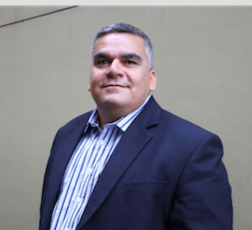We ask the buyers
Programmatic is perhaps the biggest innovation in the way media is bought and sold since the carbonless order book.
What does it mean for Radio? Will it drive ad revenues up or down? Will it make sales teams redundant? Will it make terrestrial radio less competitive against streaming services.
To find out radioinfo’s Peter Saxon spoke to two of Australia’s leading Programmatic practitioners: Victor Corones, (left) Chief Investment Officer at IPG Mediabrands and Andrew Reid (right) Head of Digital, Data and Investment at Amplifi which is part of the Dentsu Aegis Network.


What is Programmatic?
Every time I visit a website I’m identified by my well-travelled ‘cookie’ which holds a wealth of information about me gleaned from my surfing and buying habits and the personal data I’ve voluntarily revealed by filling in countless electronic forms along the way.
So, when I click onto a website that has Programmatic space available for sale, a virtual auction takes place between any number of advertisers for the right to show me, personally, their ad.
“Ladies and Gentlemen, how much am I bid for this balding middle aged male with a penchant for travel, high end hi-fi and opera? Also, he spent $xxxx dollars on wine in the past six months alone. Bidding starts at 20 cents”
The virtual auction is completed in just milliseconds with the winning bid anywhere from about 20 to 70 cents or more, depending on how well my cookie fits the brief pre-programmed by advertisers looking for targets a lot like me.
In my case, more often than not, an online wine merchant wins out. Sometimes, it’s the Salvos or Alcoholics Anonymous. I’m yet to take up what they are offering.
It seems to be an advertisers’ dream – targeting right down to the individual. A kind of reverse pay-per-view.
Can radio compete?
Reid: At the end of the day you’ve still got those mass audiences sitting on free to air which still can’t be replicated elsewhere. Just like the newspapers and just like prime time on radio. They’ve still got those mass audiences that can’t be substituted in a quick way for a lot of advertisers. It comes down to reach over time. If I was going to take all my money and take it out of free to air radio and put it on Pandora it would take me months, maybe half a year to reach that kind of audience compared to a couple of weeks on free to air radio.
Still it’s a seductive argument for advertisers to have the ability to choose which individuals are exposed to their ads.
Corones: Lot’s of other media channels add value on the path to purchase for any consumer. If you evaluate a campaign purely on what we call “last click” then that’s probably going to lead you to a search engine or the last page you looked at. However, to influence a consumer on the way, you may have been exposed to TV commercial, Radio or a Print ad as well as other digital ads.
On that path to purchase, where does radio fit in?
Corones: Radio has multiple roles – no different to what it currently does and has done for the last 50 years… close to point of purchase, raising awareness, creating desire – any of the reasons that we use radio are still relevant. What we’re looking for more and more now is can we make better decisions by overlaying other data about the type of listener we’re after?
For all its pin point targeting, programmatic still has some serious flaws. For example, I keep getting Opera Australia ads urging me to buy season tickets for months after I’ve already purchased mine.
Reid: The big issue right now is that there’s a lot of wastage in digital. We know ads are being served but we’re not sure people are seeing them. Up to half of that is unseen because it’s under a page or behind a browser, you could have multiple screens opening up. In Pandora or Spotify’s case you might have a visual coming up on your screen and you don’t view it. Just because I know more about the audience doesn’t mean that I’m connecting with that audience.
With free to air radio, while there may not be as much detail about each individual listener there’s a fair idea of how many people are listening and it can be safely assumed that most of them actually get to hear all of the content.
On top of that radio stations are getting a better picture of their audiences through their digital assets.
Reid: The music stations are very good at that, building up a huge portfolio of listeners through their social media, Facebook and so on.The more you build up a base of listeners and then translate that into audiences to be purchased in day parts is a huge opportunity for radio right now.
But radio could do a lot more ….
Reid: At the moment I don’t see radio stations saying to us here’s our core demographic in the morning and then well help you target them mid day evening and then late at night because we know so much about them. Someone else is selling those audiences, when in fact they were all drive time listeners which the station could legitimately sell, but they don’t. Instead it falls to, say, the SMH to sell them and late night tv to sell them and in fact they could have started their journey during the day when they were driving to work because they are so loyal to that particular station but that connection hasn’t been made yet.
What percentage of radio will be bought in, say, five years time on radio through programmatic?
Mr Reid, estimates that some 30% of online advertising is currently being sold through programatic but only about 1% of radio is being bought that way.
Reid: I don’t see it being a majority spend simply because you don’t have that supply issue that digital has. And in many ways digital will become so complex in terms of buying process that trying to simplify it and get down to a point where I nominate an audience I hit a button and I target those people regardless of the context that they’re in. You don’t have that luxury with tv or radio.
It is clear that programmatic’s ‘sweet spot’ is online display advertising, not traditional electronic media like radio.
One reason is supply and demand.
Reid: In a digital world there is so much remnant inventory. There is so much supply. When it comes to radio, particularly prime time spots, there’s no remnant.
A hybrid of that is catch-up tv. The online video stuff is sold up months ahead so you can’t get programmatic on catch-up but you can buy lots of YouTube video and lots of remnant video outside the 7,9,10 and SBS model because there is so much supply. But there’s no need to have an auction process for radio and outdoor when there’s not enough supply.
Corones: A lot of people see it as all about selling remnants – stressed airtime or space. But programatic brings a lot more to the table. For us, its using technology and data to streamline what we do and automate but in that process, make better purchase decisions in and around those considerations.
Nonetheless, radio does have some remnant inventory available in fringe times. If programmatic can shift some of that, then the incremental revenue will be welcome. Which may be one reason some big networks have partnered with established Programatic firms such as Triton Digital (MRN) and The Rubicon Project (SCA). The bigger picture, though, is that radio networks have become significant players in the online field where inventory abounds. And if that can be bundled in with remnants on radio, Bob’s your mother’s brother.
Reid: Radio has been very, very good recently in saying: “Commercial radio combined with online generates a better return. That’s been a very clever marketing tactic. To say, “if you are spending more on digital then you need to ramp up your radio spend as well. The two complement each other and lead to a better outcome.” I think there’s a lot of merit in that. I do know we spend a lot of money with radio and it’s still growing.
If I’m a salesperson at a radio station, should I be worried?
Reid: I think all sales people should be worried. Whether you are in digital or in radio or in tv, in the sense that the market is adjusting constantly. For example you’ve got digital sales teams with online publishers who have just as much pressure from the facebooks of the world as traditional radio has from a Spotify or a Pandora or an Apple. So there’s always pressure regardless where you are.
Corones: No, I don’t think so. There’s still a role for sales people because ultimately that person is going to know more about that environment and that property. And more and more we’re going to be looking for things that are beyond spots and dots. Whether it’s as simple as organising live reads with an Alan Jones or whether it’s looking at leveraging some of the content that’s created by a station and looking at ways to integrate our message into that.
Will programmatic ultimately drive radio ad values down?
Corones: In a programmatic environment, the media owners are provided with a lot more pricing levers than they’ve ever had because they can make really informed decisions on the fly about what they believe their individual assets are worth at any point in time.
Where will radio have to be in the next five years to be in a competitive, sustainable position in the media landscape?
Reid: I don’t think it will come down to programmatic. It won’t come down to necessarily distribution, for example. It’s going to come down to the personalities at the end of the day. Its going to come down to content and how you drive that content. It’s the only significant differentiator thats left.
Corones: What I love about radio is that it’s well connected to the local community, be it a large city or small country town. It has localisation but it also has talent. As long as radio continues to understand the new technologies that are coming but also develops strategies on how to combat those along with protecting and growing their own audience base.
We all know that content is king so if you bring the right solution to consumers they will come to it.
The challenge is that there are more and more choices out there. So, the question is what do you do in that changing landscape? How do you stand out? How do you differentiate? And then how do you add value back to the consumer in that experience? I think radio’s in a great place to do all of that but it requires some balls to make some changes.
I don’t expect any of our media partners to stand still. They moment they stand still, that’s the end of the game.
Will radio’s digital assets become their main driver of revenue?
Reid: Digital will never pay the bills. It’s always going to be that mass audience on free to air and the content that will drive that.
On Friday, the CRA Conference on the Gold Coast will feature “A Programmatic Panel with Nova Entertainment’s Cathy O’Connor, Peter Wiltshire from Nine Entertainment, Simon Ryan from Carat Aus & NZ, Mark Hollands of The Newspaper Works and Mike Tyquin from Adshel.

Peter Saxon

